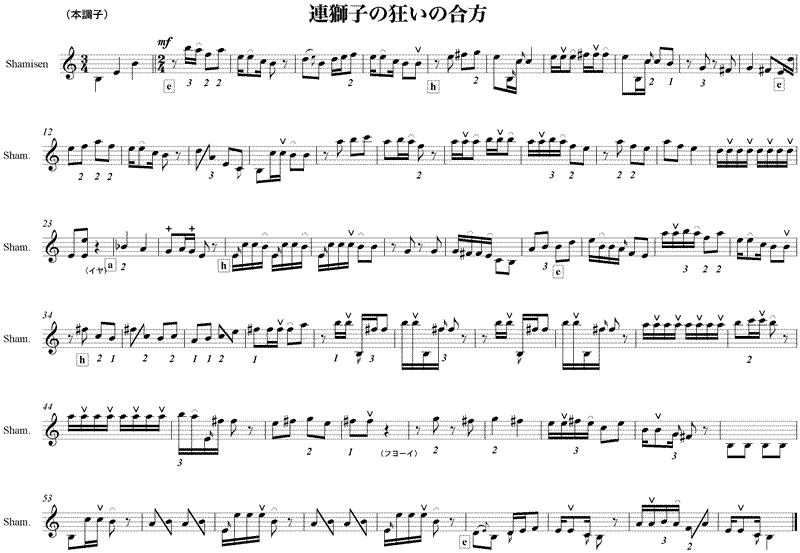Ritsu-Yang-Yin Scale
After studying some of the classical genres like naga-uta
(used in Kabuki theater etc.) and songs like ha-uta (short song) and zokkyoku
(popular song), I found a following scale could cover most of traditional practice
of hoso-zao ("narrow-pole" shamisen)
playing.
Below is a Scala print out with my notation system in E as the center tone.
Shamisen_Ritsu_Yang_Yin
0: 1/1 E unison, perfect prime
1: 27/26 F tridecimal comma
2: 9/8 F# major whole tone
3: 243/208 Gb
4: 32/27 G Pythagorean minor third
5: 81/64 G# Pythagorean major third
6: 2187/1664 Ab
7: 4/3 A perfect fourth
8: 18/13 Bb tridecimal augmented fourth
9: 3/2 B perfect fifth
10: 81/52 C
11: 27/16 C# Pythagorean major sixth
12: 729/416 Db
13: 16/9 D Pythagorean minor seventh
14: 243/128 D# Pythagorean major seventh
15: 2/1 E octave
Followings are underlying observations.
1. The Ritsu-Yang-mode is made of Pythagorean pentatonic: E-F#-A-B-D-E: A and
B are perfect 4th and 5th, and all diatonic intervals (E-F#, A-B, D-E) are
Pythagorean whole tone (9/8).
2. The Ritsu-Yin-mode is made of minor pentatonic with less-than-half tone
intervals above the tonic E and 5th B: E-C-B-A-F-E (in a descending order).
The intervals of the half tones (C-B and F-E) are not rigorous and seem
to depend genres, schools, individuals, in particular songs or phrases
etc. but they do not exceed the 12ET half tone. I prefer the string
ratio (27/26), the one-third of the whole tone intervals, which maybe
the smallest end of the spectrum. One practical reason is that the
one-third interval is very easy to locate if the whole tone positions
are marked on the pole.
3. Yang and Yin modes are freely mixed in compositions, although tones
like F and F# do not appear in same phrases.
4. In highly developed compositions like naga-utas, there are frequent
modulations of the tonal center. In most cases, the music starts in E but
temporary modulates to B or A or F# or C# and returns to E as shown by
Haiko Ohtsuka ("Pitch
Theory in the Music of the Shamisen", Ongakunotomo-sha, 1995, in Japanese).
This scale covers all the modulations shown above.
5. Since this scale is essentially Pythagorean, it is easily adapted in
MIDI hardware or software synthesizers with Pythagorean tuning by selecting
out F, C and "flat" tones into a different instrumental channel
tuned (100-65.33) cents below. By manipulating this value, it is also possible
to find out the most favorable intervals for the less-than-the-half tones.
6. I made one realization from standard naga-uta repertories using Siberius
V3 and Cubase SX3 with FM7 softsynth though no attempt
was made for faithful simulation of shamisen sounds or rhythmic modulations.
Renjisi: Sound (QuickTime Movie) played by MIDI soft-synth
Renjisi: Sound (.mp3) played by me

Back to Gene Music and Sangen Studio

